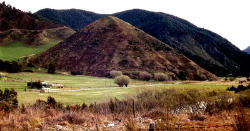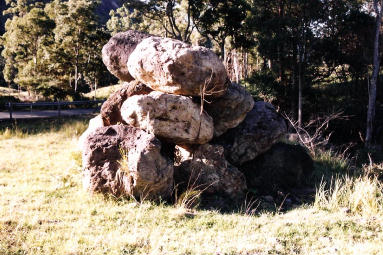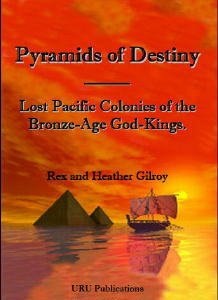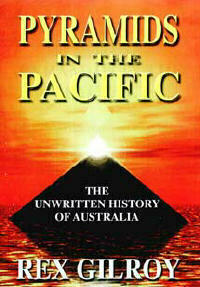
| Pyramids of Destiny – Lost Pacific Colonies of the Bronze-Age God-Kings |
 |
This ancient stone pile is one of a large number, found on a Logan River Valley property, being the remains of a Bronze-Age Phoenician cemetery.
The region lies just inside the Queensland border with New South Wales.
|
Pyramids of Destiny – Lost Pacific Colonies of the Bronze-Age God-Kings
by Rex & Heather Gilroy
Copyright
© Rex Gilroy 2009
| “Australian history is almost always picturesque; indeed it is so curious and strange, that it is itself the chiefest novelty the country has to offer, and so it pushes all other novelties into second and third place. It does not read like history but like the most beautiful lies. Mark Twain: Following the Equator [1891] |
”Every truth passes through three stages before it is recognised. In the first, it is ridiculed. In the second, it is opposed. In the third, it is regarded as self evident.” Arthur Schopenhauer [1788-1860] |
Part Three.
Lost Egypto-Phoenician Colonies of Queensland’s Far North.
Chapter Thirteen.
Ghostly Graves of the Logan Valley.
All removable rock inscriptions described in this chapter were removed for safe
keeping and research by the authors.South of Brisbane lies Redland Bay on the west side of North Stradbroke Island. It is from this bay that the Logan River begins its winding journey westward past Beenleigh, before turning southward through Beaudesert past Rathdowney into Mt Barney National Park on the New South Wales/Queensland border. The whole region forms the Logan Valley, which prospectors during the 19th century discovered to be rich in gold, tin and copper, besides gemstones.
Recent geological investigations hereabouts have resulted in the discovery of rubies, which together with another location in the Barraba region of the New England district, New South Wales, are the only currently known localities for rubies in Australia. The valley’s rich volcanic soil makes it excellent farming land and properties cover the full extent of the valley, which lies beneath tall cliffs rising high above dense rainforest jungles.
The entire region has a mysterious feeling about it and a distant view is to be had of a sphinx-outlined mountain. How appropriate therefore that this valley should hold the scattered remains of an ancient mining and farming colony, established by Phoenicians in Bronze-Age times!
For generations tales have been emerging from this valley, of a ‘lost pyramid’ hidden somewhere in those jungles, of mysterious rock inscriptions which just might happen to be ancient Middle-Eastern scripts, and a gold scarab [an object of worship of the ancient Egyptians] recovered on a Logan River farming property early in the 20th century.
There is a similar tale of a gold scarab having been ploughed up at Kyogle, further south inside the New South Wales border, while Phoenician-type rock scripts are rumoured to have been found years ago in the Lamington National Park, in the Border Ranges inland from the coast.
And then there are the numerous old Aboriginal legends, of a mysterious race of “culture-heroes” who once came to the region, to build structures of stone and worship the Sun. It was the many tales of mysterious finds in the Logan River Valley that led Heather and I to begin field investigations of the region in May 2001.
We searched a few places but the dense rainforest which covers these areas defeated our initial attempts, to uncover any remains of ancient colonisation which might still survive hidden there. Leaving Heather in our vehicle I decided to tackle some dense forest at the base of high cliffs past which a creek flowed.
Battling my way through the vines and fallen tree trunks in amongst all the bush was no easy task, and falling over more than once I was glad I had not brought Heather along for this particular search! Then, amid all the dense leafmould and fallen bracken, I noticed large lumps of volcanic basalt, which gave the appearance of having formed a tall stone wall which had long ago fallen away. Over an area in the dark forest depths, I recognised outlines of basalt stones forming the square and round remains of apparent ancient dwellings.
There were no signs of broken bottles or other debris to suggest these ruins to be those of some long-forgotten 19th century mining camp. I soon afterwards found piles of copper ore, covered by leaves nearby ancient open-cut operations at the base of a hillside, but the dense foliage made a proper investigation of this find almost impossible. The ore lay scattered about the forest floor and with difficulty I followed it until it broke out into the open, trailing down a slope into the creek.
Photography was hopeless in that dark, vine tangled forest world, and I wondered how much farther these remains of ancient mining and settlement might extend through that “green hell”. Perhaps I will fight my way back into there one day and see what else lies hidden. However, I would only carry out a search there in the winter months, because once the warm weather returns the forest is alive with deadly tiger snakes.
I returned to the car and Heather drove me up a remote dirt road through more jungle terrain, where I came across more fallen stonework of large square basalt rocks that appeared to have formed some massive structure, perhaps an ancient temple. Yet it was situated in very difficult terrain, composed of masses of tangled vines and other plant growth, and I decided to leave it until the next trip.
Upon following a dried up occasional creek bed near the Logan River, I spotted ahead of me, high up on the flats above the creek bed, several 2-3 metre tall pyramidal piles of large, roundish basalt boulders, extending in a line from north to south. The thought immediately crossed my mind that I had seen photographs in European archaeological literature, of identical formations identified as ancient Phoenician grave markers dating back 2,000 to 3,000 years of more.
The huge stones forming these mounds would have to have been rolled and lifted into place by a number of workmen, and as I observed that there were no signs of volcanic activity at this particular spot, it was obvious that these heavy boulders had been transported to this location from at least a couple of kilometres away where basalt outcrops existed.
As I searched around the immediate area of the northernmost of these pyramidal markers my eyes spotted first one, then another inscribed stone, one a small flat granite slab, the other a half pebble. The inscriptions were old Canaanite. I immediately placed these in my backpack and continued to examine all of the stone piles, which I measured, sketched and photographed.
It was apparent that I had stumbled upon an ancient Phoenician cemetery. Just beyond the southernmost of these pyramidal grave markers I came upon a large granite boulder bearing a Canaanite inscription in large letterings, beyond which was a wall of arranged granite boulders. I recorded these finds and after a thorough search of the surrounding area, having found nothing more I returned to Heather at the car.
Our adventures that day were not yet over, because as we passed through Rathdowney our car broke down. After contacting the RACQ at a local shop we waited for the repair man to arrive. As luck would have it, near the roadside while looking around we found a 26.5cm tall by 29cm width and 10cm thick message stone” which had once stood upright upon the hill we were on overlooking the Logan River.
There, carved upon both sides of this basalt rock was a lengthy Canaanite Phoenician inscription cut into both sides! I for one was so excited that I hardly noticed the arrival of the RACQ mechanic as I washed and studied the inscriptions. The inscriptions discovered that day were translated in motels along the way home to Katoomba. They were to prove quite revealing.
The half-pebble inscription read simply:
“Jessy our ruler brought us to this land”.
The small basalt slab inscription read:
“The City of our ruler, Jessy of Qumran”.The boulder containing the large Canaanite letterings proved to be a single grave marker stone, the inscription reading simply; “Woe is Yaga”.
The large Rathdowney “message stone” spoke of the arrival of colonists, to what we now realised was a large colony. It stated:
“In this ship of Baal the Sun,
Captain Yata, son of I-na, our commander,
brought us to this settlement, from the land of Dan
of the Canaanites over the ocean”.Here was a colony that extended far inland from the mouth of the Logan River where there had to have been a coastal base. It had to have supported a massive population at its height, and therefore farming had also to have been practiced here on a grand scale to feed the people.
There was a central city hereabouts where the ruler of the colony, “Jessy of Qumran” presided. The fallen stoneworks and the impressive, if crude grave markers, show that here was a permanent mining colony which attracted regular shiploads of colonists.
Main Book Index | Mysterious Australia Homepage | URU Homepage | Australian Yowie Research Centre

